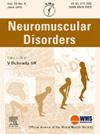Identifying novel AGRN variants in congenital myasthenic syndrome: insights from three Iranian families
IF 2.7
4区 医学
Q2 CLINICAL NEUROLOGY
引用次数: 0
Abstract
Congenital myasthenic syndromes (CMS) are rare inherited disorders characterized by defective neuromuscular transmission, with the AGRN gene recognized as a notable yet infrequent cause of CMS. This study aims to delineate the clinical and molecular characteristics of three Iranian patients diagnosed with AGRN-related CMS. Whole exome sequencing (WES) was performed, leading to the identification of three novel variants in the AGRN gene. One patient had a homozygous indel variant, another patient had a missense mutation in a homozygous state, and a third patient had two missense variants that were inherited in a compound heterozygous manner. Each patient exhibited distinct clinical presentations ranging from progressive weakness, fatigue, to muscle atrophy and this heterogeneous clinical presentation contributed to diagnostic delays. Electrophysiological studies confirmed neuromuscular junction disorder through significant decremental responses after repetitive nerve stimulation. Treatment outcomes varied, demonstrating the complexity of therapeutic efficacy among patients with agrin mutations. These findings underscore the phenotypic diversity associated with AGRN mutations and emphasize the challenges in the diagnosis and management of CMS. This research enhances understanding of the clinical and molecular landscape of AGRN-related CMS in Iranian patients and highlights the importance of tailored therapeutic strategies.
鉴定先天性肌无力综合征中新的AGRN变异:来自三个伊朗家庭的见解
先天性肌无力综合征(CMS)是一种罕见的遗传性疾病,其特征是神经肌肉传递缺陷,而AGRN基因被认为是CMS的一个显着但不常见的原因。本研究旨在描述三名伊朗患者诊断为agn相关CMS的临床和分子特征。进行全外显子组测序(WES),鉴定出三个新的agn基因变异。一名患者有一个纯合的indel变异,另一名患者在纯合状态下有一个错义突变,第三名患者有两个以复合杂合方式遗传的错义变异。每个病人都表现出不同的临床表现,从进行性虚弱、疲劳到肌肉萎缩,这种异质的临床表现导致了诊断的延迟。电生理学研究通过反复神经刺激后显著的减少反应证实了神经肌肉连接障碍。治疗结果各不相同,表明了基因突变患者治疗效果的复杂性。这些发现强调了与agn突变相关的表型多样性,并强调了CMS诊断和管理中的挑战。这项研究加强了对伊朗患者中与agrn相关的CMS的临床和分子景观的理解,并强调了量身定制治疗策略的重要性。
本文章由计算机程序翻译,如有差异,请以英文原文为准。
求助全文
约1分钟内获得全文
求助全文
来源期刊

Neuromuscular Disorders
医学-临床神经学
CiteScore
4.60
自引率
3.60%
发文量
543
审稿时长
53 days
期刊介绍:
This international, multidisciplinary journal covers all aspects of neuromuscular disorders in childhood and adult life (including the muscular dystrophies, spinal muscular atrophies, hereditary neuropathies, congenital myopathies, myasthenias, myotonic syndromes, metabolic myopathies and inflammatory myopathies).
The Editors welcome original articles from all areas of the field:
• Clinical aspects, such as new clinical entities, case studies of interest, treatment, management and rehabilitation (including biomechanics, orthotic design and surgery).
• Basic scientific studies of relevance to the clinical syndromes, including advances in the fields of molecular biology and genetics.
• Studies of animal models relevant to the human diseases.
The journal is aimed at a wide range of clinicians, pathologists, associated paramedical professionals and clinical and basic scientists with an interest in the study of neuromuscular disorders.
 求助内容:
求助内容: 应助结果提醒方式:
应助结果提醒方式:


